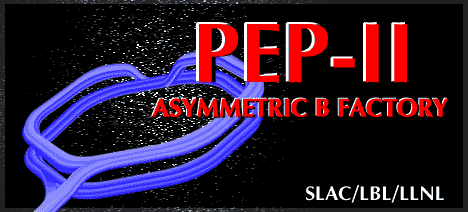 10/03/01 Update
10/03/01 Update  10/03/01 Update
10/03/01 Update PEP-II Update October 3, 2001
The PEP-II run in 2001 started in February after a three-month installation period. After some turn on issues and initial vacuum scrubbing for the LER, PEP-II started to deliver colliding beams to BaBar with machine studies interspersed. The early machine studies concentrated on reducing the beta x* in both rings and understanding the RF feedback and control systems. The results with PEP-II collisions showed that reducing both beta x*s from 50 cm to 35 cm was too large a step at one time and the beta changes were removed. The RF stability studies started to pay off allowing high currents to be stored. Starting in April PEP-II went into an integration-only mode to provide as much data as possible to BaBar by the summer conferences. PEP-II delivered and integrated a total of about 38 fb-1 to BaBar by the end of June. Even without machine studies, the luminosity increased from February to June from 1.8 to 3.2 x 10**33/cm**2/s. BaBar published in early July its "sine2beta" results on CP violation.
In July weekly machine studies were resumed with the aim of increasing the currents and increasing the specific luminosity per bunch. The HER and LER beam orbits, after slow degradation over the previous months, were resteered and significantly improved. The dispersion and coupling were corrected. By the end of August the luminosity was up to 3.6x10**33/cm**2/s. In August a simple knob on the beta x* in the HER was developed to allow fine control. This knob was used several times over the next month to adjust the relative strength of the HER and LER during collisions. By the end of the September the horizontal beta x* had been lowered from the measured 80 cm to about 65 cm. The HER and LER betatron tunes were carefully adjusted. The specific luminosity at low currents was above 3.8 x 10**30/cm**2/s/mA**2. The luminosity reached 4.214x 10**33/cm**2/s on October 1. On a different front, initial studies to bring the LER and HER horizontal tunes to just above the half integer resonance have started with considerable success but the performance in collision is not yet sufficient to try the new tunes during BaBar delivery shifts.
PEP-II (and SLAC) had to watch the power budget during the summer but, in the end, ran remarkably well given the circumstances. Over that time, SLAC had no blackouts but had about five brownouts during which we were asked to reduce our load for several hours.
The various PEP-II performance levels as of October 3, 2001 are: The peak luminosity is 4.21x10**33/cm**2/s with BaBar taking data. At the peak luminosity the HER current was 925 mA and the LER current 1620 mA in 728 bunches. The best integrated luminosity in an eight hour shift is 96.1 pb-1 delivered and 91.8 pb-1 recorded by BaBar. The peak integrated luminosity delivered in a rolling consecutive 8 hours is 100 pb-1. The best integrated in three consecutive shifts is 281.6 pb-1 delivered of which BaBar logged 268.5 pb-1. The best delivered luminosity in seven days is 1.47 fb-1. In the month of September 2001 PEP-II delivered 5.08 fb-1 for its third month above 4 fb-1. Overall, PEP-II has produced a total of 53.7 fb-1 since May 1999.
The plan for PEP-II is to run continuously until the end of June 2002 with a short break at the end of the calendar year for the holidays and a "one-week" maintenance down in early January. There is a planned three-month down in Summer 2002 to install two RF stations for PEP-II and to rework the end-cap IFR for BaBar. Of course, this plan is subject to congressional, programmatic, and electric power constraints.
----John Seeman and Michael Sullivan for the PEP-II Staff (10/3/2001)
Suggestions to: John Seeman
[PEP-II Commissioning Updates] [PEP-II Home Page] [BABAR Detector Home Page] [SLAC Home Page]
Page owner: achan